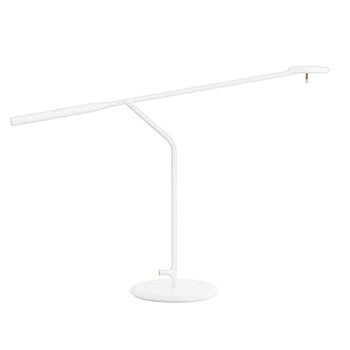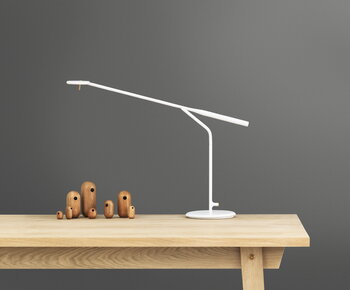Normann Copenhagen’s Flow table lamp, designed by Andreas Kowalewski in 2017, is an interesting, refined LED lamp for decorating and lighting up a desk, office or reading corner. The flowing design of the lamp consists of easily adjustable metal arms which grow into each other organically like branches on a tree. Soon after its launch, the Flow lamp was awarded a German Design Award Gold 2018.
Flow table lamp, white
Normann Copenhagen
Description
Normann Copenhagen’s Flow table lamp, designed by Andreas Kowalewski in 2017, is an interesting, refined LED lamp for decorating and lighting up a desk, office or reading corner. The flowing design of the lamp consists of easily adjustable metal arms which grow into each other organically like branches on a tree. Soon after its launch, the Flow lamp was awarded a German Design Award Gold 2018.
Product details (22)
- Material
- Powder coated metal
- Colour
- White
- Length
- 58 cm
- Width
- 16 cm
- Base diameter
- 16 cm
- Height
- 42 cm
- Light source
- Fixed 5.4W LED (included)
- Colour temperature
- 2,000–3,000 K
- Luminous flux
- 350 lm
- Lifetime
- 30,000 h
- IP rating
- 20
- Protection class
- III
- Voltage
- 220–240 V
- Nominal frequency
- 50–60 Hz
- Certifications and labels
- EU: CE marked: tested and approved according to European standards
- Plug
- EU: EU-plug / US: US-plug
- Cable length
- 200 cm
- Cable colour
- White
- Cable material
- Textile
- Weight
- 3.2 kg
- Integrated switch
- Yes
- Dimmable
- Yes
- Product ID
Designer
Andreas Kowalewski is a German designer, who has graduated as a industrial designer from the Folkwang University of Arts in Essen, and now runs his own studio in Hamburg. Kowalewski has won many highly valued design prizes, such as the Red Dot Product Design Award, IF Product Design Award and German Design Award.
View all productsReviews (0)
Sustainability
The Product Sustainability Framework, our criteria of sustainable design, helps you find the most sustainable products in our selection. Read below which sustainability criteria this product has met.
Working conditions & labour 7/9
-
Equal opportunities for all employees
-
Commitment to UN Global Compact, fair compensation for all employees
-
Corporate responsibility requirements defined and communicated for suppliers
-
Systematic work for improved inclusion and well-being in the workplace
-
Transparent supply chain
-
Suppliers' compliance to a code of conduct ensured
-
Compliance to the UN Guiding Principles on Business and Human Rights ensured in the supply chain
-
Direct suppliers audited and certified
-
Support for community involvement in the supply chain
Eco-friendly production 6/9
-
Fair and resource-wise water-use in production
-
No incineration or landfilling of returned items
-
No use of endangered species as materials
-
No direct environmental emissions or waste (excl. GHGs) from production
-
Material-efficient and ecological packaging
-
No potentially harmful chemicals used in own production
-
The sustainability of direct suppliers' production is addressed and monitored
-
Production and material sourcing that respect biodiversity, animal rights, and natural ecosystems
-
Positive impact on nature’s well-being through operations that regenerate natural ecosystems
Climate impact 4/8
-
Company's direct greenhouse gas emissions identified and commitment to reduction
-
Product's carbon impact identified and commitment to reduction
-
Guidance on energy- and eco-efficient use of the product
-
Contribution to climate initiatives beyond the brand’s direct operations
-
Low-carbon or compensated transportation
-
Carbon footprint of the product calculated and goals set to reduce it
-
100 % renewable energy in own production and operations
-
Carbon neutral or carbon negative product
Sustainable materials 3/6
-
Sustainable and long-lasting material choices
-
No harmful or hazardous substances
-
Responsible raw material sourcing and production
-
Materials suited for circularity: monomaterials, recyclable finishings, renewable or recycled contents etc.
-
Ecological materials: natural, biodegradable, recyclable or recycled contents
-
Outstanding materials in terms of innovativeness, responsibility, sustainability and circularity: local production or sourcing, 100 % recycled content, C2C-certification etc.
Circular design 3/5
-
High aesthetic quality promoting long-term use of the product
-
Design for enduring life-long quality
-
Design and support for product maintenance, repair and upgradability
-
Technically durable product design and material choices
-
Innovative circular design solutions: circular service system, resale platform, remanufacturing, collection of used products, etc.








